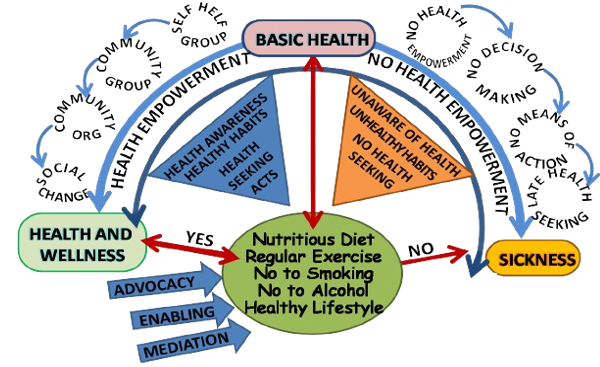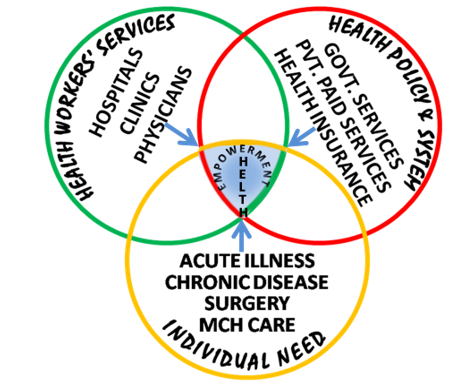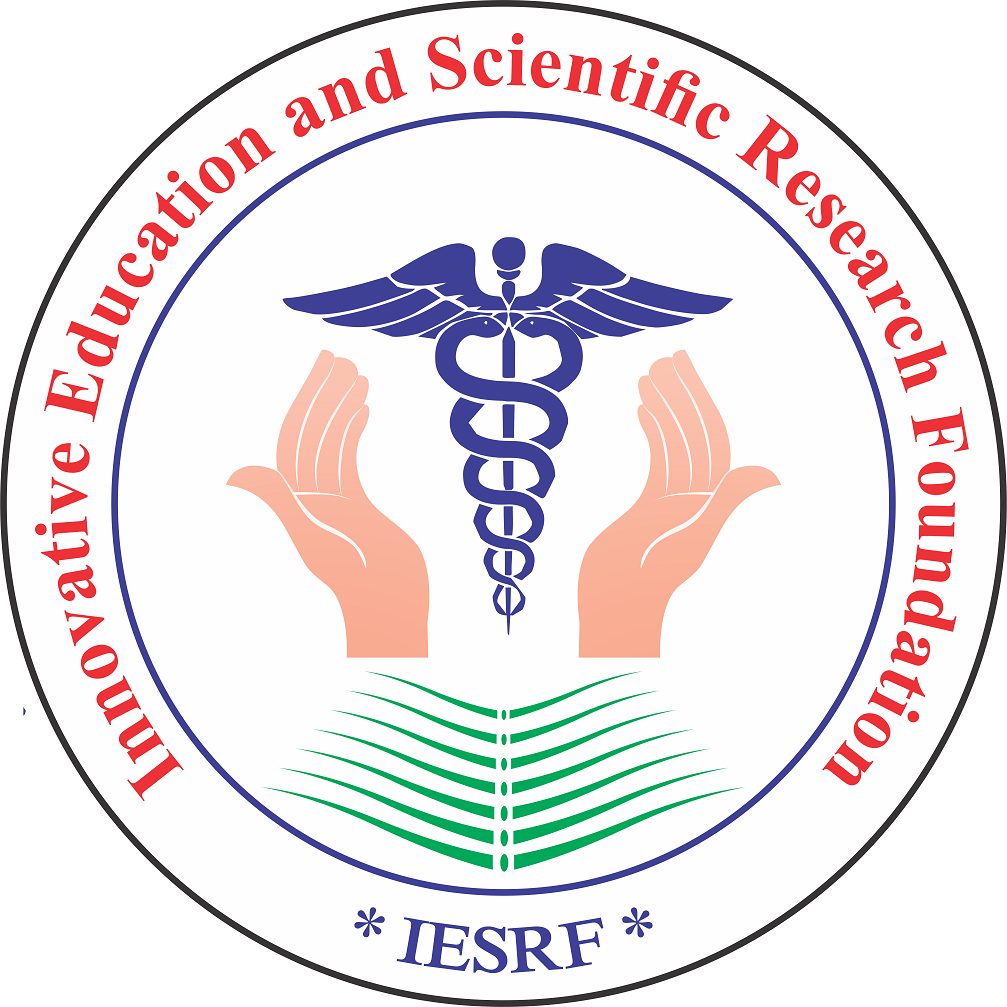- Visibility 231 Views
- Downloads 26 Downloads
- Permissions
- DOI 10.18231/j.jchm.2024.021
-
CrossMark
- Citation
Defending resilience: Health empowerment to sustainable development
- Author Details:
-
Jyotishman Mukhopadhyay *
Abstract
The premier global conference on Health Promotion was organized in Ottawa in 1986, with the intent to strategize the dispensing of primary health care among the poor mitigating inequities to achieve the ‘Health for All’ by 2000 AD. Poverty is a collective setback in India that’s unarguably attached to ill health with high mortality. Socio-demographic, environmental, economic, and political reasons often control the health of the community furthered by the after-effect of COVID pandemic, eerie climate, and clout of conflicts around the globe. Poverty breeds ill-health, and ill-health makes the poor - poorer. Health empowerment, a central spire of health promotion and disease prevention, refers to a process through which people gain greater control over the decisions taken on their health, wellness, and health-related quality of life. This article endeavors to ascertain the value of health empowerment in the background of dispensing of Primary Health Care to achieve sustainable development in future.
Introduction
The first International Conference on Health Promotion was convened in Ottawa in 1986, and was primarily a response to growing expectations for novel public health movement around the world.[1] It tossed a series of actions among international organizations, national governments, and local communities to achieve the goal of "Health for All" by the year 2000 and beyond. The basic strategies for health promotion identified in Ottawa Charter were -Advocacy (boost the factors that encourage health), Enabling (allow all to achieve health equity) and Mediating (collaboration and convergence of inter-sectoral interests).
Poverty is a universal problem especially so in India that unwaveringly relates to ill health with high mortality rates. [2] World Bank estimated around 270 million Indians living ‘Below Poverty Line’ which depicts approximately 1 in every 5 citizensbeing poor of whom around 45% are illiterate.[3] 80% of poor Indians live in rural areas and work as casual labour in agricultural farm and small-scale industries. They have restricted access to nutritious food, clean water, and safe shelter; the poverty-stricken children experience limitations in growth, development and opportunities for education extending into adulthood.[4] Difficulty in accessing and availing healthcare is another common problem among the poor families. Payment for healthcare may divert theirmere disposable income fromother day-to-day requirementsthereby often compromising the health exigencies as such. Even loss of wage and work for the day for hospital visit could cost dearly upon them resulting in health denial. Therefore, it is natural that poverty and poor health run hand-in-hand inextricably orbiting a vicious cycle lasting for generations in the family.[5] Media, newspaper, and TV broadcast hardly publicize any agenda on poorer section instead try to instil the glitz and glamour of rich by portraying the envying golden life of celebrities among the common.
Aim
This chronicle tries to establish the worth of health empowerment in the background of dispensing of Primary Health Care among the poor to achieve sustainable development goals in future.
The Problem
WHO pronounced Alma-Ata Declaration in 1978 stating that ‘Primary Healthcare is thelinchpin to Health for all by 2000 AD’ and that was further reiterated as ‘Primary Health Care - Now More than Ever’ in 2008.[6] Primary healthcare begins with self-care to promote health, prevent disease, and manage illnesses. Health is overwhelmingly bigoted by extramural issues beyond the health and wellness domain, especially by socio-demographic, environmental, economic, and political counts further compounded by the aftermath of COVID pandemic, eerie climate, and clobber of conflicts around the globe. These forces largely influence the circumstances in which people subsist, nurture, work, and mature as well as utilize the existing social and public beneficiary support systems to deal with regular health needs but ultimately unknowingly quiver into inequities in health within the communities because the poverty breeds ill-health, and ill-health makes the poor - poorer.[7], [8] Health empowerment, a central pinnacle of health promotion and disease prevention, refers to a process through which people gain greater control over the decisions taken on their health, wellness, and health-related quality of life (HRQOL). The concept of health empowerment is to edify and enable individuals and families so that they can have the knowledge, motivation, self-efficacy, means of action, resilience, and resources to stay healthy and seek health services appropriately. Factual worth of know-how would transform into wisdom of action in the face of challenges for health and diseases.
Novel approach
To counter the challenges due to the changing scenarios in social, demographic, epidemiological, food security, environmental, climatic, and financial front, health empowerment has emerged as an important tool; a novel and contemporary approach that need no exaggeration. Considering the dire need of the hour ‘Health Promotional Hospitals’ (HPH) have been reformed in India by restructuring renowned tertiary care hospitals following the WHO HPH policy.[9], [10], [11] Efforts are needed to build more health promoting set-ups like schools, hospitals, and work places for empowering the poor.[7] Community sessions on stress management, nutritious diet, lifestyle reformation, self care measures for diabetics and hypertensives, curtailing smoking & alcohol intake, and free health check-ups are regular recognized cues so that the citizens can be contacted, educated, and counselled as required. Empowerment of the underprivileged by enhancing health literacy through health education and mitigating their medico-social and psycho-emotional demands will go a long way to resolve the prevailing disparity directing the community towards sustainable development.
Health Empowerment
Being oriented to patient-centred philosophy, health empowerment construes that individuals are responsible for their own health. Health empowerment focuses on keeping individuals informed, encouraging their active participation in decision-making to achieve self-efficacy with regard to health matters, especially so for the locally endemic diseases, chronic illnesses, pregnancy and child health, epilepsy, asthma, and even mental disorders to some extent. It makes the patients act differently, rather than solely being dependant on paternalistic hospital and medical advices for resolving the health issues in the face of financial oppression and indisposition ([Figure 1]). With the expected widening of the income inequality in days to come, and the close relationship between poverty and poor health, assisting the working marginalized vulnerable group by empowering them on common health issues, including up-scaling their health awareness and health-seeking attitude, is essential for quality healthcare services planning, execution, and expansion.

Individuals in the community at large will have to avail the privately or publicly provided health care services for anything beyond the most minor ailments that can be managed by

health awareness. Desirable competence with respect to health matters is not medical knowledge, but rather the ability to seek medical care from the existing system when needed. Health Empowerment will be rewarding when Health Worker’s Services and Health Policy System would function synchronously in a harmonized way to enable the individual get facilitated at the time of need at minimum cost borne ([Figure 2]). [12]
Health Empowerment, Economic Independence and Sustainable Development
The number of healthcare beneficiaries with complex needs is increasing day by day; health care workers need training and education regarding issues that can empower such users from their own perspectives, in order to access and avail high-quality care. Health empowerment emphasizes facilitating one’s awareness and capability to participate knowingly in health maintenance and health care decisions expressive of a human health pattern of well-being and is viewed as a relational process that emerges from the recognition and utilization of personal, social, and contextual resources. [13], [14]
Successful empowerment would enable most clients including the chronically indisposed to cope with their diseases by improving their self-reliance and self-efficacy maintaining positive health to achieve active life, productivity and economic independence fostering sustainable development in the long run. Healthy life and financial freedom ultimately help to lead a socially and economically productive life for these empowered individuals.
New UG MBBS Curriculum: Family Adoption Program
Family Adoption Program initiated by the National Medical Commission in India for UG MBBS students in the recent past seamlessly incorporated these intents, evincing the worth of holistic sustainable development and the intertwined association between health and collective well-being by the medical educationists and academicians.[14], [15] A genuine and empathetic approach of reaching out to the community evoking the power of unity to transform lives, saving the planet, lifting people out of poverty, advancing economic growth these are one and all the same struggle for all of us, [16] considering the services to others is the tariff paid for the sojourn on this earth. The journey through this indite is likely to awaken our sense of responsibility and the vital role that each one of us can play in paving the way for a healthier future not just in the bustling cities but also across the quiet villages transcending all limits - truly encompassing the spirit of inclusivity.
Conclusion
Health empowerment has become a desirable worth espoused by the health care planners, health administrators, medical academicians, social thinkers, and justice activists. Therefore, recent years have been characterized by increasing calls for empowerment of both health care employees and the community members they serve. Empowering community with health awareness and health seeking behaviour is undoubtedly a unique approach to bring justice for availability of ‘Primary Health Care’ in rural as well as urban India resolving all inequities in the broader perspective of ‘Health for All’, fostering the ‘Sustainable Development’ in health and economy in near future.
Source of Funding
None.
Conflict of Interest
None.
References
- . The Ottawa Charter for Health Promotion: The 1st International Conference on Health Promotion, Ottawa, 1986. . . 1986. [Google Scholar]
- Wagstaff A. Poverty and health sector inequalities. Bull World Health Org. 2002;80(2):1-27. [Google Scholar]
- . World Bank. India’s Poverty Profile. . 2016. [Google Scholar]
- Duncan G, Yeung W, Brooks-Gunn J, Smith J. How much does childhood poverty affect the life chances of children?. Am Sociological Rev. 1998;63(3):406-23. [Google Scholar]
- Yoshikawa H, Aber J, Beardslee W. The effects of poverty on the mental, emotional, and behavioural health of children and youth: Implications for prevention. Am Psychol. 2012;67(4):272-84. [Google Scholar]
- . Pan American Health Organization. The World Health Report 2009 - PHC: Now More Than Ever. . 2008. [Google Scholar]
- WHO. Commission of Social Determinants of Health. Closing the gap in a generation: health equity through action on the social determinants of health. Final Report of the Commission on Social Determinants of Health. . 2008. [Google Scholar]
- . World Report on Social Determinants of Health equity. . 2005. [Google Scholar]
- Goel S, Gupta A, Ahuja P, Jain B, Bains P, Goel S. Comparison of the health promoting orientation of three tertiary care hospitals of India. Nat Med J India. 2011;24(2):83-5. [Google Scholar]
- Whitelaw S, Baxendale A, Bryce C, Machardy L, Young I, Witney E. ‘Settings’ Based Health Promotion: A Review. Health Promot Inter. 2001;16:339-53. [Google Scholar]
- Whitelaw S, Martin C, Kerr A, Wimbush E. An evaluation of the Health Promoting Health Service Framework: the implementation of a settings based approach within the NHS in Scotland. Health Promot Int. 2006;21(2):136-80. [Google Scholar]
- Menon S. Toward a model of psychological health empowerment: implications for health care in multicultural communities. Nurse Educ Today. 2002;22(1):28-39. [Google Scholar]
- . Multi-cultural communities. Sociology. 2002;22:28-39. [Google Scholar]
- Shearer N. Relationships of contextual and relational factors to health empowerment in women.. Res Nurs Pract. 2004;18(4):357-70. [Google Scholar]
- Shearer N, Reed P. Empowerment: Reformulation of a non-Rogerian concept. Nurs Sci Quart. 2004;17(3):253-9. [Google Scholar]
- . Family Adoption Program finds its place in New MBBS curriculum. . 2022. [Google Scholar]
How to Cite This Article
Vancouver
Mukhopadhyay J. Defending resilience: Health empowerment to sustainable development [Internet]. J Community Health Manag. 2024 [cited 2025 Sep 14];11(3):116-119. Available from: https://doi.org/10.18231/j.jchm.2024.021
APA
Mukhopadhyay, J. (2024). Defending resilience: Health empowerment to sustainable development. J Community Health Manag, 11(3), 116-119. https://doi.org/10.18231/j.jchm.2024.021
MLA
Mukhopadhyay, Jyotishman. "Defending resilience: Health empowerment to sustainable development." J Community Health Manag, vol. 11, no. 3, 2024, pp. 116-119. https://doi.org/10.18231/j.jchm.2024.021
Chicago
Mukhopadhyay, J.. "Defending resilience: Health empowerment to sustainable development." J Community Health Manag 11, no. 3 (2024): 116-119. https://doi.org/10.18231/j.jchm.2024.021
